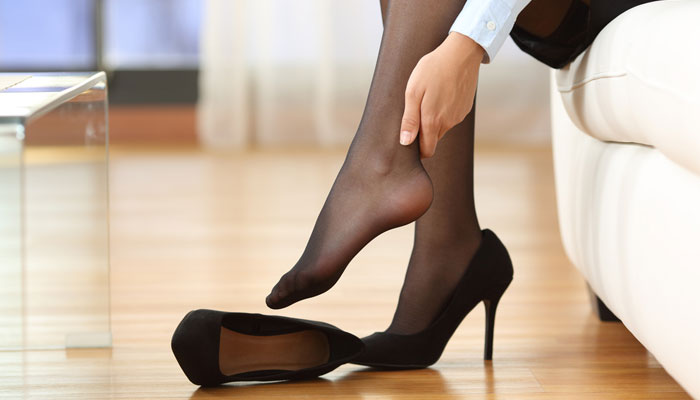As we stampede our way to the dizzying heights of fashion, we’re unmindful of the wincing pain and orthopedic disorders we face in the future because high heels promise instant pleasure.
However, there are a bunch of high heel problems,that we need to be vary of. Read on, to know more about the harmful effects of high heels:
The A, B, C whodunit writer Sue Grafton once said that if high heels were so wonderful, men would still be wearing them. But her observation hasn’t stopped Victoria Beckham from tottering on her Manolo Blahniks and our home-grown fashionistas from slipping into their Jimmy Choo’s, while the less privileged among us settle for locally made slip-ons that elevate us to dizzying heights.
In a perverse way, we’re all life members of the sisterhood of pointed heels that cause wincing pain even as they promise instant pleasure. Feminist author Elizabeth Wurtzel spoke for all of us when she said, “I like wearing high heels, not because they make my feet feel good. I get blisters on my toes and heels, and yet I feel absurdly and obscenely delighted in the shackles of womanhood that cause this unnecessary pain.” Rare is the woman who doesn’t groan with relief as she slips off her stilettos at the end of the day. There’s a moment of transcendence that crosses her face, something conspicuously absent when she kicks off her Nikes after a round at the gym.
The stiletto heel. Most adore them while a tiny minority abhors them. But whichever side you veer on, you can’t deny that they do make even the stumpiest among us feel sassy and swan like, never mind if they kill our feet afterwards. But as we stampede our way to the heights of fashion, few of us stop to ponder the effect that these impossibly high heels have on our spine and feet. Even trend-setting fashionistas, who spend their days lunching and preening for photographers in sky-high heels, aren’t immune; fashion icon Sarah Jessica Parker, who played Carrie Bradshaw in Sex and the City, tore tendons in her foot as she stumbled down the street in stilettos.
It's no wonder that feet are particularly susceptible to the rigors of high heels. There are 26 bones in each foot, that’s 52 in all. This translates to a quarter of all the bones in your body being compressed beyond comprehension each time you slip on those high heeled contraptions. High heels are beautiful, elegant, even sexual, but should you be wearing them all the time? Orthopedists say high heels can be dangerous for the spine. Long-term wear thrusts your center of gravity forward, causing additional pressure on the spine, besides increasing the chances of your knees retiring on pension earlier than you. Research shows that wearing stilettos puts 25 percent more pressure on your poor knees and hips each time you take a step.
Orthopedists identify two categories of problems caused by high heels, immediate and long-term. The immediate conditions include sprains and fractures from rolling ankles, particularly caused by those lethal spike-heeled stilettos. That wider heels are safer is a common misconception. Wider heels are deceptive because while they may give you more stability laterally, they tend to get over-used, with most women rarely taking them off to give their legs a rest.
In the long term high heels can cause toe deformities like bunions—that Posh Spice now sports peeping through her Ferragamos—hammer toes and corns. They can even trigger nerve compression by narrowing the toes and pushing them together. Over time, the condition could get serious and arthritis and collapsed arches are not uncommon in those who swear by the uplifting properties of stilettos. Experts say the key is to wear fashionable shoes only as needed, at say weddings or important business meetings and where you need to look dressed up. Even then, the heel shouldn’t be any higher than an inch and a half.
So is there any kind of shoe that diva aspirants can hope to safely wear without causing long term damage? The perfect shoe should be one with hardly any support, and with no heel, or half an inch at the most. But looks and style are important too. Orthopedists recommend wearing supportive shoes as far as possible. Designer spikes and non-supportive loafers look cool but don’t allow for easy, symmetrical walking. Take frequent stretch breaks even while sitting to stretch your hamstrings. And don’t forget to keep a comfortable pair of shoes handy to slip into whenever you get the chance.


